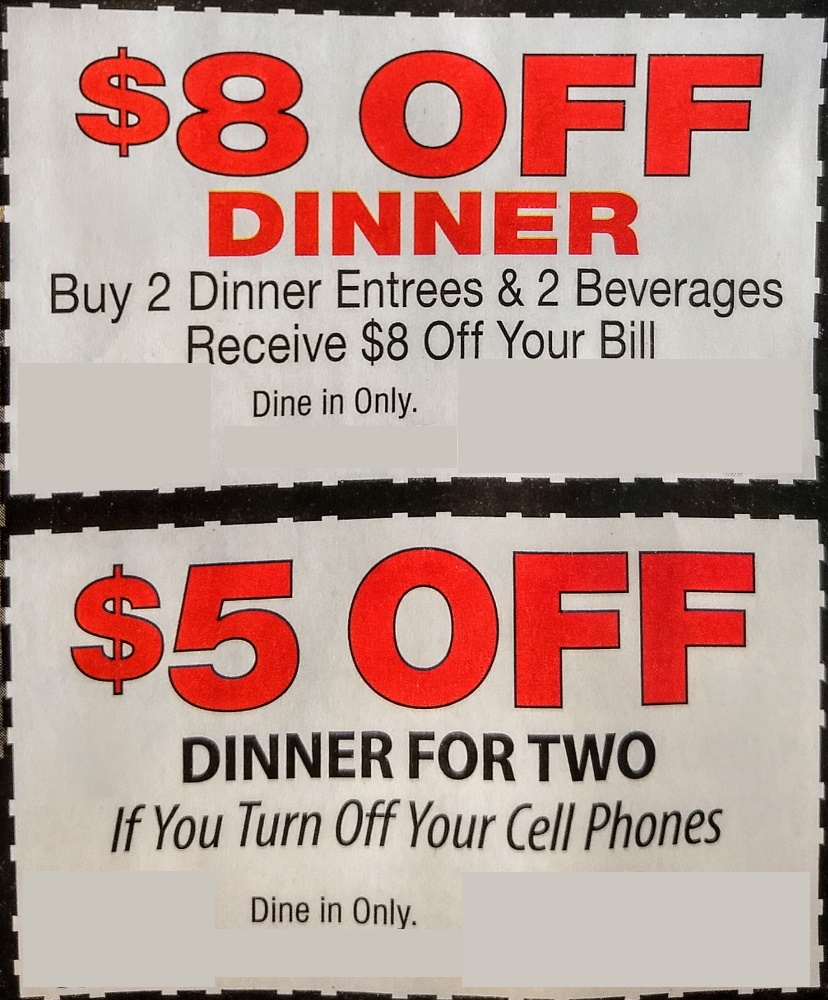Edited, updated, and republished post from my previous website.
Communication is a tricky thing. It’s complex. It’s multi-layered. It can be subjective as h-e-double🏒.
That said, IMHO this coupon that came in my weekly circular is a communication flop.
But First…
To clarify, I’m not throwing shade at this restaurant. (Which is why I’ve obscured its identity.) I’m sure it’s a perfectly nice place with good people working there — and they’re all just doing the best they can with what they’ve got. Like the rest of us!)
Rather, I’m taking this as an opportunity to examine perceptions (and weaknesses) in communication and offer alternative approaches that could be more effective. Let’s learn and strive to improve!
Yes, some of what I offer are my opinions. Or based on or colored by my unique perspective.
However, I do come to the table with ample experience and background related to marcom. My observations and suggestions draw on lots of things: common sense, functional knowledge, trial and error, etc.
As such, I’m confident that you’ll see the intent of this post and grasp the ideas I’m sharing in that spirit. Basically, I’m advocating for thoughtfulness, practicality, and alignment in communications.

8 Reasons We Have a Communication Failure
Here are some reasons. And, just so you don’t think I’m nothing but a naysayer, I’ve dappled in suggestions, alternative approaches, and fixes!
#1 Practicality, Hello-o?!
How are they going to implement this?
You can’t necessarily tell if a device is off. It’d be pretty invasive for your waiter to check throughout your meal. And, if you say your phone was off during the meal but you turn it on afterward — you know, to calculate that tip — are they going to argue with you and deny the discount?
There’s just no good way to enforce the terms of this coupon. If creating a quiet or distraction-free dining experience is important to the restauranteur, I’d search for other ways to achieve this goal.
#2 We’re Living in a Connected World
What about other connected devices? Are they asking you to turn off your watch or fitness tracker, too?
Again, this isn’t really practical, appropriate, or enforceable.
#3 Social Media Foodies
No phone = no camera = no snapshots = no posting. We all know those folks who live by the creed, “If there’s no pic of it, it didn’t happen.”
It’s fairly commonplace to photograph meals or check in at restaurants. This is second nature to many.
Besides, why wouldn’t a restau want folks publicizing its biz FOR FREE?! Unless their restaurant/food are or appear to be unappetizing….
The takeaway (← See what I did there? Geez, I ❤️ puns!) here is: Let people share their experiences with your business. In fact, leverage this as a way to engage with them even more (e.g., via contests and giveaways). User-generated content can be a total boon for a biz — very powerful!
#4 In¢entive$
OK, so you can get $8 off your meal or you can get only $5 off but you also need to shut down your phone? That doesn’t make sense.
The math incentivizes you to do the $8-off deal and your ringing phone be damned. (This assumes that the cost of drinks isn’t crazy or you’d be buying beverages whether your phone was on or off.)
It’s a good idea that the enticements are valuable to customers, the numbers work, and the messaging connects the two. And remember that there’s a “cost” to asking your customers to do something in exchange for the discount — they may not feel it’s worth it to go phoneless for an hour just to get a buck or two knocked off their bill.
#5 Purpose & Clarity
What are they trying to accomplish with the ad/coupons? Get bodies in the door or create a certain kind of ambiance?
I’d guess they’re running this promotion to get people to eat at their establishment. If so, the whole piece in the circular should be about the food, the environment, the service, etc. to entice new and repeat customers.
#6 Align the Promo
Consider adjusting the offer.
Instead of stipulating turning off cell phones, the restaurant could offer a deal for dinners who come in during the typically slower hours. This would mean customer traffic — and the corresponding noise — would be more spread out.
The net effect is that it would be quieter during the traditional “dinner” hours because there’d be less of a rush of hungry-hungries. (And, this might reap other operational benefits for a biz, too.)
#7 Goal-Oriented Comms
There are other — more appropriate and sensible — ways to promote a quiet, undistracted dining experience.
- Firstly, it’s a bit weird to ask people to turn off their phones in your restau before they’ve even decided to go there. Tell them when they arrive.
. - Which leads me to a second point. Asking for specific behaviors should be done at the place where the behavior is desired. It’s more in context and bounded. It’s within the confines of the private establishment being visited.
. - Lastly, there are many opportunities and methods of making the actual request in a polite-yet-assertive way: Post a sign at the hostess stand, put it at the bottom of every page of the menu, etc. Phrase it as a request like “For the comfort and enjoyment of all diners, please turn off or silence your cell phone. Thank you!” (More casual or quirky businesses can take liberties with the messaging so that it fits their voice/tone/theme/etc.).
#8 It’s Not All About the Coupon
In addition to digital and print communications, you can architect an environment that supports your desired behaviors or ambiance.
For example, if the aim is to have a quiet restaurant:
- Install carpets, curtains, and upholstered chairs/banquettes.
- Use cloth napkins and tablecloths.
- Space out and stagger tables so they aren’t all aligned in a sound wave-amplifying formation.
- Have potted plants and other decorations.
- Opt for the occasional column, post, or divider in the dining room instead of a vast, airy space.
- Avoid having an open loft.
- Don’t blare loud background music.
Big, open areas and hard surfaces exacerbate noise; soft surfaces and intimate spaces absorb sound.
You get the idea — design the physical to match the objectives.

So What, You Say?
Perhaps this all seems a bit nit-picky. Maybe. I’d like to argue, though, that words and structures and so on matter.
What you put out there is a representation of your biz and its values, priorities, personality, etc. How do you want others to think or feel about your business? You should use all the tools at your disposal to create a positive, enduring impression and to convert prospects into customers.
Extrapolate, Please!
This post uses a restaurant as the example. But we’ve all probably seen needless communications blunders in other sectors. These pitfalls and insights can be applied to countless other businesses.
It just takes some time, patience, thoughtfulness, and caring. And a bit of skill and practice. (If you lack any of these qualities, I’m here for you! Say Hi! today — I can help you out. 👍)
Your Thoughts on This?
What do you think of this coupon/advert — is it acceptable to you or falling short? What do you think about tying intent to the form and message? Do you have examples of what you think are advertising flops? What makes for a stellar promo communication?
Get Communication Help
If you’re feeling stuck when it comes to bizcoms, you’re not alone. It’s an area of specialization, just like accounting or web development — or what you do!
But don’t fret. I’ve got you covered in three ways:
- DIY Help. SB Success Factor is all about providing tools to enable and empower you to achieve business successes. Check out the growing suite of resources and start moving yourself and your biz forward.
. - DWY Help. Sometimes you just need a bit of a helping hand, either to get started or along the way. I’m available to work with you on communications and other biz ops projects.
. - DFY Help. If you’re looking for someone to take communications and related tasks off your hands entirely, I’m your gal for this, too! I offer bespoke services so it’s easy to craft a solutions package that’s 100% the right fit.
.




![How I [Try To] Connect with My Target Audience](https://suzannebrick.com/wp-content/uploads/2024/05/lady-screaming-1024x683.jpg)
